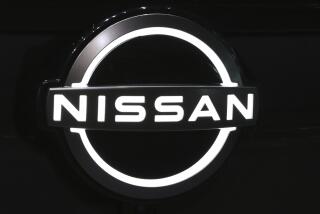A Look At Common Devices on Newer Vehicles to Make Driving Safer for All on the Road
- Share via
Air Bags
* Depending on the speed at impact and the stiffness of the object struck, front air bags inflate to prevent occupants from hitting the dashboard, steering wheel, and windshield. Side air bags reduce the risk that occupants will hit the door or objects that crash through it.
* Driver and front passenger air bags are standard equipment in all 1999 model year vehicles. In March 1997, the National Highway Traffic Safety Administration (NHTSA) allowed automakers to reduce the power of their air bags by 20 to 35 percent.
* Many automakers are including redesigned air bags in 1999 vehicles. Ask your local dealer for information about changes in air bag design and performance.
* On-off switches. An on-off switch can deactivate driver or passenger air bags. Vehicles without rear seats, or with small rear seats, such as pickups and sports cars, may have a passenger-side, on-off switch as standard equipment.
Head Injury Protection
* Head injury protection consists of foam or other energy absorbing material under the trim of the vehicle interior and is likely to be invisible. Some vehicles have head air bags.
* Both types of protection are designed to shield occupants from injuries caused when their head strikes the upper interior of a vehicle.
* By 2003, all vehicles must meet new federal standards for head injury protection. Charts show which 1999 vehicles already meet them.
Anti-lock Brake Systems
* Anti-lock brake systems (ABS) prevent a vehicle’s wheels from locking during “panic” braking and allow the driver to maintain steering control as the vehicle slows--a key factor in avoiding a collision. However, the brakes do not guarantee your ability to avoid a crash, especially when you have to stop suddenly. Furthermore, you still may lose control when driving at excessive speeds or when using extreme steering maneuvers.
* All passenger cars equipped with ABS have four-wheel ABS. Sport utility vehicles, trucks, and vans equipped with ABS can have either four-wheel or two-wheel ABS. Four-wheel ABS monitor and control all the wheels of the vehicle, while two-wheel ABS only monitor and control the rear wheels. The full benefits of ABS are not available to the driver with a two-wheel ABS.
Traction Control
* Traction control systems improve vehicle stability and steering during acceleration by controlling the amount the drive wheels can slip when you apply excess power.
* The system automatically adjusts the engine power output and, in some systems, applies braking force to selected wheels during acceleration and cornering. Traction control is mainly found on vehicles with four-wheel, anti-lock brake systems.
Source: NHTSA






